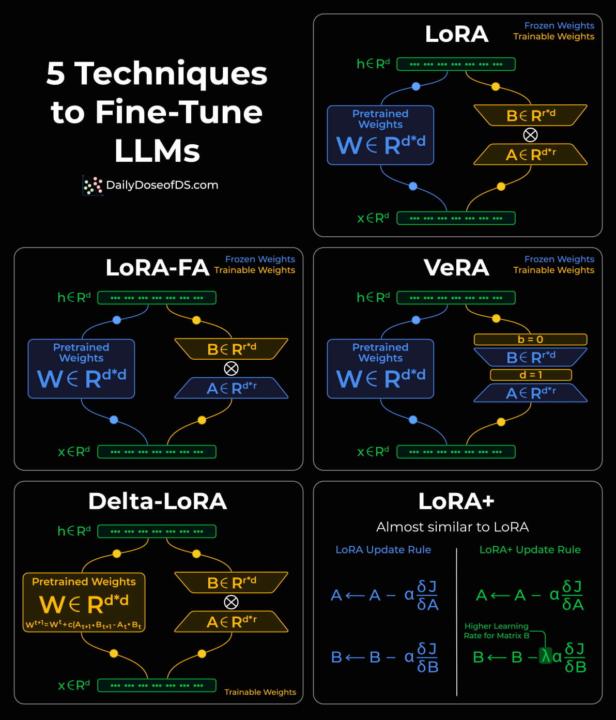AI bubble is going to burst
https://www.dw.com/en/ai-bubble-about-to-pop-as-returns-on-investment-fall-short-chatgpt-microsoft-nvidia-grok-elon-musk/a-74636881 Warren Buffett hold cash, he is waiting for crash https://www.gobankingrates.com/investing/strategy/why-warren-buffett-holds-more-cash-than-fed-signals-about-market/
5 Techniques to Fine-Tune LLMS
LLMs are very large, so instead of changing all their weights, we use parameter-efficient fine-tuning to only train small parts. Methods like LoRA, QLoRA, prefix/prompt tuning, adapters, and BitFit add tiny extra layers or low-rank updates while keeping the main model frozen. This saves memory and compute, lets people train on normal GPUs, and makes it easy to reuse one base model for many different tasks.
0
0

Black Friday deal for all Kubernetes and cloud-native enthusiasts!
📘 Kubernetes Recipes — my latest book, packed with practical guides for container orchestration and deployment — is now featured in the Humble Tech Book Bundle: Linux for Professionals by Apress & Springer. 🔧 Whether you're scaling clusters, automating deployments, or prepping for the CKA, this book has you covered. 💥 For just €23.41, you get 22 high-impact books, and part of it goes to charity. A huge bargain for leveling up your Linux and DevOps skills. 🕒 Only a couple of days left — grab it while it’s hot: Humble Bundle link #Kubernetes #DevOps #Linux #Ansible #CloudNative #CKA #BlackFriday #HumbleBundle
Kubernetes Recipes Book!
If Kubernetes still feels like a black box, this is for you. 🔥 I’ve just launched my new book “Kubernetes Recipes: A Practical Guide for Container Orchestration and Deployment” – and it’s built to solve your real problems, not add more theory to your reading list. Instead of long explanations, you get copy-paste-ready, battle-tested recipes you can use directly in your clusters. 💡 What you’ll get inside: 🧩 149+ practical recipes for day-to-day Kubernetes work 🚀 From installation & API fundamentals to advanced scaling, monitoring & troubleshooting 🔐 Security recipes to protect your clusters with sane, production-ready defaults 📦 Storage, volumes & config best practices with real YAML examples 🛠️ Integrated ecosystem: Helm, logging, Prometheus, Grafana, and more 🎙️ Want more context? Check out our appearance on De Nederlandse Kubernetes Podcast – Episode #100, where we talk about the book, real-world Kubernetes war stories, and give away copies to the community. 👉 Ready to level up your Kubernetes game? Get Kubernetes Recipes (Apress / Springer Nature, ISBN 979-8-8688-1324-5) on Amazon or directly via the publisher and turn Kubernetes from “mysterious” into “mastered.” https://kubernetes.recipes/ If you pick it up, comment or DM me which recipe you tried first—I’m genuinely curious what lands hardest in your environment. #KubernetesRecipes #Kubernetes #DevOps #CloudNative #SRE #PlatformEngineering #LucaBerton #Apress
0
0

Kubernetes Recipes: Your Practical Guide to Mastering Container Orchestration
Tired of "hello world" tutorials? Dive deep into production-grade Kubernetes with "Kubernetes Recipes," the ultimate hands-on guide for developers, operators, and DevOps professionals. This comprehensive book by Luca Berton and Grzegorz Stencel is designed to bridge the gap between basic concepts and real-world engineering challenges. Whether you're deploying on bare metal, in the cloud, or on a hybrid infrastructure, these practical, standalone chapters provide the solutions you need to build, scale, and manage your containerized applications with confidence. Get your copy now: https://amzn.to/3DzC8QA Inside "Kubernetes Recipes," you'll discover: - Chapter 1: Getting Started: Launch a Kubernetes cluster in minutes on any OS with tools like kubectl, k3s, Minikube, and KinD. You'll even find walkthroughs for high-availability, hybrid, and Raspberry Pi clusters. - Chapter 2: Configuring Stateless Applications: Master the essentials of deploying lightweight services, including namespaces, multi-container Pods, and resource limits to keep your applications running smoothly. - Chapter 3: Configuring Stateful Applications: Learn how to manage databases and other stateful workloads with practical examples for PostgreSQL, including persistent volume claims, backups, and migrations. - Chapter 4: Kubernetes on Cloud Providers: Avoid vendor lock-in with step-by-step guides for GKE Autopilot, AKS, EKS, DigitalOcean, and more, using the CLI or Terraform. - Chapter 5: Developer Experience: Supercharge your workflow with tips for the CLI, Helm, Kustomize, and integrations with popular tools like Lens IDE and VS Code. - Chapter 6: Scaling & Resiliency: Implement advanced scaling strategies with HPA, VPA, and KEDA, and learn zero-downtime rollout techniques like blue-green and canary deployments. - Chapter 7: Storage: Get a deep understanding of persistent data in a cloud-native world, with end-to-end walkthroughs for NFS, EFS, Azure Disks, and more. Download a FREE sample of this chapter: https://kubernetes.recipes/ - Chapter 8: Networking: Go beyond the basics to master traffic management, security, and observability with Ingress, Istio, Cert-Manager, and ExternalDNS. - Chapter 9: Performance Observability: Build a unified observability stack with Prometheus, Grafana, ELK, and Jaeger to quickly troubleshoot any issue. - Chapter 10: Control-Plane Admin & Helm: Operate your clusters like a pro with a deep dive into the API-server, etcd, and advanced Helm techniques. - Chapter 11: Security: Implement robust security practices with Pod Security Admission, AppArmor, Seccomp, and RBAC walkthroughs. - Chapter 12: Emerging & Advanced Concepts: Stay ahead of the curve with insights into FaaS, eBPF, Cilium, WASM, and AI/ML pipelines on Kubernetes. - Chapter 13: Best Practices: Distill years of experience into practical checklists for GitOps, capacity planning, health checks, and cost control. - Chapter 14: Additional Resources: Connect with the cloud-native community and discover the business case for Kubernetes.
0
0

1-30 of 306
powered by

skool.com/ai-devops-ansible-community-6317
AI DevOps Mastermind by Luca Berton: AI, DevOps, Kubernetes & Terraform. Access 50+ hours of courses, hands-on labs, and career-boosting mentorship!
Suggested communities
Powered by


